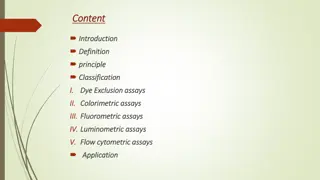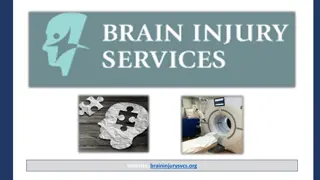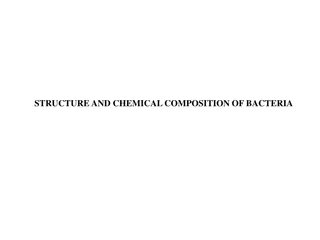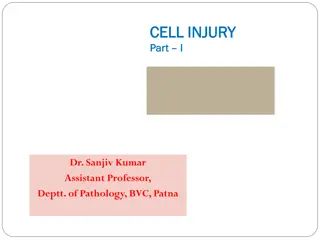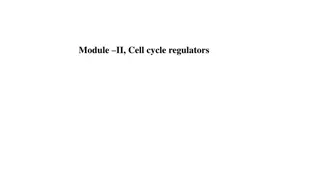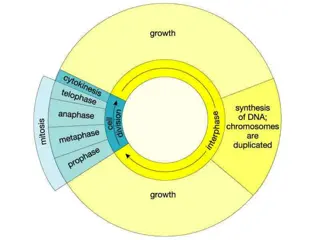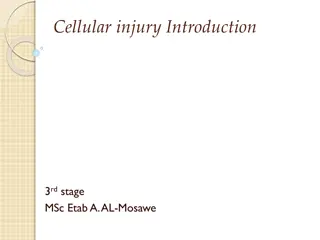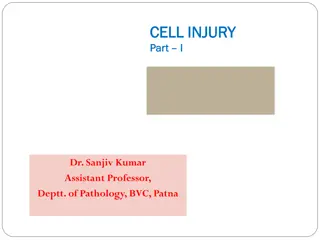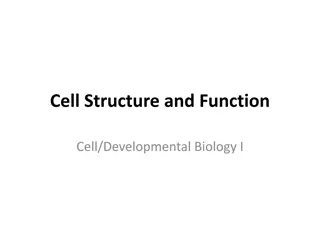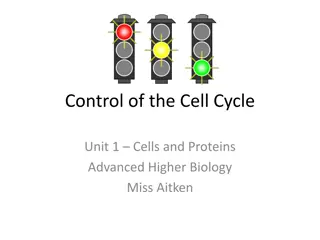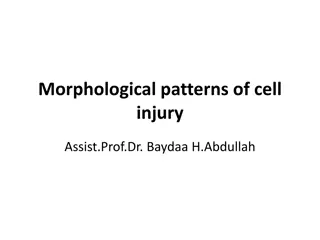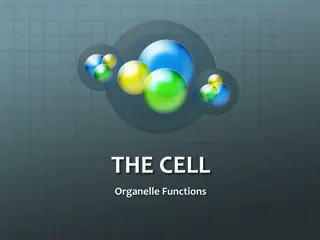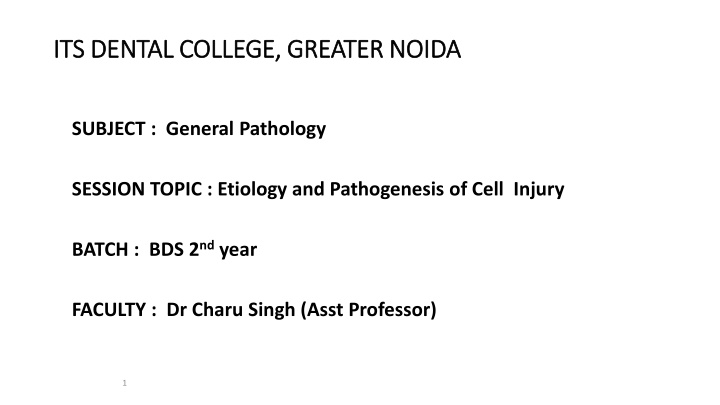
Etiology and Pathogenesis of Cell Injury in General Pathology
Explore the causes and processes involved in cell injury in the context of general pathology. Learn about reversible and irreversible cell injury, genetic and acquired causes, and the general principles underlying cell injury responses. Enhance your knowledge of types of cell injury, including hypoxic, chemical, and physical injury. Gain insights into the cellular mechanisms that lead to cell injury and the essential components affected. Dive deep into the key learning objectives and outcomes related to cell injury in this educational session at ITS Dental College, Greater Noida.
Download Presentation

Please find below an Image/Link to download the presentation.
The content on the website is provided AS IS for your information and personal use only. It may not be sold, licensed, or shared on other websites without obtaining consent from the author. If you encounter any issues during the download, it is possible that the publisher has removed the file from their server.
You are allowed to download the files provided on this website for personal or commercial use, subject to the condition that they are used lawfully. All files are the property of their respective owners.
The content on the website is provided AS IS for your information and personal use only. It may not be sold, licensed, or shared on other websites without obtaining consent from the author.
E N D
Presentation Transcript
ITS DENTAL COLLEGE, GREATER NOIDA ITS DENTAL COLLEGE, GREATER NOIDA SUBJECT : General Pathology SESSION TOPIC : Etiology and Pathogenesis of Cell Injury BATCH : BDS 2ndyear FACULTY : Dr Charu Singh (Asst Professor) 1
Learning Objectives & Specific Learning Outcomes Learning Objectives: To explain the Etiology and Pathogenesis of Cell Injury Specific Learning Outcomes: At the end of the lecture, the learner should have knowledge of the following :- Types Of Cell Injury Etiology of Cell Injury Pathogenesis of Reversible Hypoxic Cell Injury Pathogenesis of Hypoxic, Chemical and Physical Injury Free Radical Mediated Injury
Etiology and Pathogenesis Of Cell Injury
Introduction Cell injury results when cells are stressed so severely that they are no longer able to adapt or when cells are exposed to inherently damaging agents or suffer from intrinsic abnormalities
Types Of Cell Injury Two types- Reversible Cell Injury Irreversible Cell Injury
Causes Of Cell Injury Genetic Causes Acquired Causes
Genetic Causes Deficiency of functional proteins Accumulation of damaged DNA or misfolded proteins Variations in the genetic makeup.
Acquired Causes Hypoxia and ischemia Immunologic Reactions Physical Agents Nutritional Imbalances Chemical Agents and Drugs Infectious Agents
General Principles of Cell Injury The cellular response to injurious stimuli depends on the nature of the injury, its duration, and its severity. The consequences of cell injury depend on the type, state, and adaptability of the injured cell. Cell injury results from different biochemical mechanisms acting on several essential cellular components
Pathogenesis According to type of injury- Pathogenesis of Hypoxic/Ischemic Injury Pathogenesis of Chemical Injury Pathogenesis of Physical Injury
Pathogenesis of Hypoxic/ ischemic injury
Reversible Cell Injury If the stimulus is acute and brief or mild, the cell injury produces changes in the cells which are reversible up to a certain point Biochemical mechanisms Decreased generation of cellular ATP Intracellular lactic acidosis: Nuclear clumping Damage to plasma membrane pumps: Hydropic swelling & other membrane changes Reduced Protein synthesis : Dispersed ribosomes
Morphological Changes Microscopy - Two main features Cellular swelling failure of energy dependent pumps in plasma membrane inability to maintain ionic and fluid homeostasis small clear vacuoles seen within the cytoplasm (hydropic change or vacuolar degeneration) Fatty change appearance of lipid vacuoles
Ultrastructural changes of reversible cell injury Plasma membrane alterations - blebbing, blunting and loss of microvilli Mitochondrial changes - swelling and the appearance of small amorphous densities Dilation of the ER intracytoplasmic myelin figures Nuclear alterations - disaggregation of granular and fibrillar elements
Irreversible Cell Injury Persistence of ischaemia or hypoxia results in irreversible damage to the structure and function of the cell cell death Two essential phenomena distinguish irreversible from reversible cell injury : Inability of the cell to reverse mitochondrial dysfunction on reperfusion or reoxygenation. Disturbance in cell membrane function
Biochemical mechanisms Calcium influx: Mitochondrial damage Activated phospholipases: Membrane damage Intracellular proteases: Cytoskeletal damage Activated endonucleases: Nuclear damage Lysosomal hydrolytic enzymes: Lysosomal damage, cell death and phagocytosis
Morphology Nuclear changes- Pyknosis - condensation of nuclear chromatin Karyolysis - dissolution of pyknotic nucleus Karyorrhexis - fragmentation of pyknotic nucleus
Ischemia-Reperfusion Injury Restoration of blood flow to ischemic tissues can promote recovery of cells if they are reversibly injured, but can also paradoxically exacerbate the injury and cause cell death Mechanisms Oxidative stress Intracellular calcium overload Inflammation Activation of the complement system
Free Radical-Mediated Cell Injury Free radicals are chemical species that have a single unpaired electron in an outer orbit Unpaired electrons are highly reactive and attack and modify adjacent molecules, such as inorganic or organic chemicals proteins, lipids, carbohydrates, nucleic acids key components of cell membranes and nuclei Reactions are autocatalytic - molecules that react with free radicals are themselves converted into free radicals, thus propagating the chain of damage
Types of Free Radicals Oxygen derived free radicals: Reactive oxygen species (ROS) are oxygen-derived free radicals. Eg superoxide anion (O2 ), hydrogen peroxide (H2O2) and hydroxyl ions( OH) Reactive nitrogen species/nitric oxide (NO) derived free radicals: e.g. nitric oxide (NO),peroxynitrite anion (ONOO ), NO2 and NO3 . Free radicals from drug and chemical
Generation Of Free Radicals Reduction-oxidation reactions that occur during normal metabolic processes Absorption of radiant energy Rapid bursts of ROS are produced in activated leukocytes during inflammation NADPH oxidase Enzymatic metabolism of exogenous chemicals or drugs Transition metals such as iron and copper donate or accept free electrons - Fenton reaction NO (by endothelium, macrophages, neurons) ONOO- (peroxynitrite anion), NO2 and NO3
Pathologic Effects of Free Radicals Lipid peroxidation in membranes - double bonds in unsaturated fatty acids of membrane lipids are attacked by O2-derived free radicals, particularly by OH Oxidative modification of proteins Lesions in DNA
Conditions With Free Radical Injury Ischemic reperfusion injury Radiation injury by causing radiolysis of water Chemical carcinogenesis Cellular aging Inflammatory damage
Removal of Free Radicals Spontaneous decay Free radical scavenging systems
Pathogenesis Of Chemical Injury Chemicals induce cell injury by one of two general mechanisms: Direct toxicity - chemicals can injure cells directly by combining with critical molecular components. For eg :- Mercuric chloride poisoning - mercury binds to the sulfhydryl groups of cell membrane proteins increased membrane permeability and inhibition of ion transport Cyanide poisons mitochondrial cytochrome oxidase inhibits oxidative phosphorylation Conversion to toxic metabolites - toxic chemicals are converted to reactive toxic metabolites, which then act on target molecules. For eg :- CCl4 highly reactive free radical CCl3 lipid peroxidation Acetaminophen toxic product cell injury
Frequently Asked Questions 1) Describe etiology and pathogenesis of Hypoxic Cell Injury 2) Write short notes on :- Free Radical Injury Antioxidants Myelin Figures
Reading List/Reference List Robbins Basic Pathology: Kumar, Abbas, Aster, 9th Edition Essential Pathology for Dental Students: Harsh Mohan, Sugandha Mohan, 5th Edition


